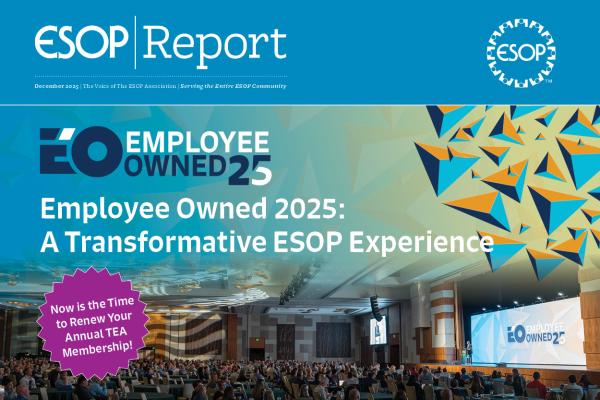People and organizations nationwide and policymakers from both political parties admire ESOPs for their distinct identity and positive impact. They are built on longevity, transparency, and ownership. While an ESOP company can certainly go out of business or transition to a traditional ownership structure, the ultimate goal of an ESOP company is for employees to carry on the culture, success, and legacy of the business in its community. As the company’s stock price grows and the number of employees increases, the benefits of the ESOP grow along with it, rewarding the workers and promoting retirement savings. Congress has consistently supported ESOPs because of these societal benefits. Therefore, no one should be allowed to co-opt ESOPs with a new plan that offers neither permanence nor long-term benefits nor actual ownership.
To emphasize TEA’s stance on the efforts by private equity firms to promote their equity-sharing programs: the Association does not oppose private equity firms granting or sharing equity with their employees. Their ongoing effort to share the upside of a transaction with their employees is laudable. However, this proposed new structure is absolutely not an ESOP and should not be labelled as such. In fact, any plan to provide costly private equity tax breaks and exemption from core ERISA worker protections is an existential danger to ESOPs, and one TEA must oppose.
Why? There are several reasons.
1. Redefines ESOPs
The Expanding ESOPs plan (STEPs) proposes a new, special, protected qualified retirement plan labelled an ESOP. But this new plan carries none of the hallmarks of ESOPs – ownership, transparency, longevity, or protections for workers. It is inferior for workers and mostly benefits investors. Calling an apple an orange doesn’t make it so.
2. Crowds out ESOPs
Business owners face the choice of selling to their employees and inviting DOL oversight, or selling to private equity, possibly for a premium, without government involvement. If Congress grants private equity huge tax incentives and “safe harbor” immunity from regulations designed to protect employees, why would any future business owner sell to an ESOP? Every PE firm would use this generously subsidized and legally protected model. Over time, this model would subsume the ESOP market, ironically, in the name of “ESOPs.”
3. PE Failures Jeopardize ESOPs
Not all private equity investments end with successful, profitable businesses anchored in their communities. A large percentage of PE-backed companies cut jobs or even declare bankruptcy. The ESOP community should not allow Congress and the public to conflate the failures, layoffs, and closures of a separate and distinct model with ESOPs, which successfully protect workers and keep jobs in communities.
4. ESOPs Blamed When PE Promises Don’t Pan Out
Expanding ESOPs is selling a model to Congress and workers as an “ESOP” with “ownership.” Neither term is accurate. An ESOP’s promises are contractual, real, and irrevocable – not so for STEPs. When workers get laid off or depart, when profits don’t hit their target, or when the numbers just don’t pencil out, workers will be shortchanged and likely resentful. The current positive reputation of ESOPs and pride in being an owner will evaporate.
5. Current ESOP Tax Treatment Joined to Private Equity
Allowing the new STEP proposal to be called ESOPs joins the two of them together for future tax policy debates. It’s understandable why PE wants to connect to ESOPs, but should the ESOP community connect its future to PE? If current ESOP tax provisions are lumped in with those of Expanding ESOPs, then Congress will “score” them together, making ESOPs very “expensive” in the eyes of policymakers. There’s a saying that, “Pigs get fat, while hogs get slaughtered.” Expanding ESOPs proposals will place a distinct target on ESOPs’ backs in future tax legislation. ESOPs face little danger from Congress in this regard today, so inviting controversy is a mistake.
6. Jeopardizes the Bipartisan Political Support for ESOPs
For decades, ESOPs have built bipartisan support, cherished by the ESOP community, and which has been positive for employee ownership. Yet PE has been a lightning rod for several reasons. ESOP Champions on both sides of the political aisle will shift positions when private equity deals are rebranded as “ESOPs”.
7. Expanding ESOPs Jeopardizes Other ESOP Issues
ESOPs have seen extraordinary public policy gains over the past year. The ESOP community is on the precipice of landmark changes designed to spark growth for ESOPs. Key personnel in the President's Cabinet and sub-Cabinet positions are clear supporters of ESOPs, and they reached those positions with bipartisan support. The tax and regulatory proposal by Expanding ESOPs jeopardizes those gains, whether it passes or not. When legislators see a divided community supporting multiple proposals, they typically respond by doing nothing. A unified community with a unified voice is the most effective strategy. This debate, which could last several years, jeopardizes:
• The American Ownership Resiliency Act (AORA), which incentivizes private capital to finance ESOPs, will become more difficult to pass.
• The Employee Ownership Fairness Act, addressing section 404 and 415 limits for employee owners, could be viewed as too costly when combined with PE tax breaks.
• Litigation reform, critical to growing ESOPs, would be complicated by the pursuit of narrow “safe harbors” for a preferred investor class called “ESOPs.”
Expanding ESOP’s public support is largely based on a high-priced public relations campaign, coupled with a stealth lobbying campaign, all resting on just 120 words of carefully crafted principles. The ESOP Association’s members have generated real momentum for removing the existing regulatory roadblocks to ESOP formation, including bipartisan and bicameral support for legislation to bring private capital to the table to support ESOP growth. This is what support for creating more ESOPs should look like.
ESOPs have always been about properly balancing capitalism with values, as evidenced through the widespread treatment of employee owners. Removing the “values” side of this equation leaves it unbalanced. No one should be able to buy or force a redefinition of what makes ESOPs special.
Here’s the inescapable conclusion about Expanding ESOPs plans:
They don’t create, protect, or benefit employee owners like ESOPs. They lack decades of independent research proving their multiple benefits like ESOPs. They are not retirement plans like ESOPs. They are not a finance mechanism, as Kelso and Senator Long designed, like ESOPs. They do not preserve a founder’s legacy or provide long-term succession, like ESOPs.
Simply put, STEPs should not be called or call themselves ESOPs. Therefore – They should not trade on research or decades of bipartisan goodwill built up by ESOPs. They should not receive massive taxpayer incentives in the name of ESOPs. And they should not pursue special legal immunity (aka a “safe harbor”) as ESOPs. STEPs are not ESOPs.








